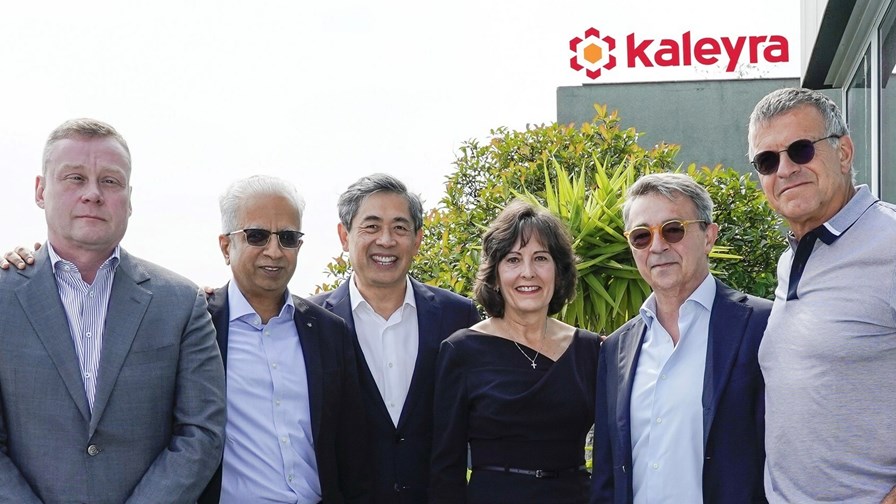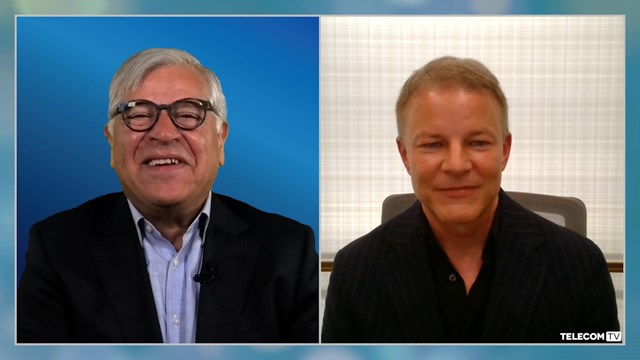
From Left to Right: Troy Reynolds, Chief Legal & Compliance Officer, Tata Communications; Mysore Madhusudhan, EVP - Collaboration and Connected Solutions, Tata Communications; Tri Pham, Chief Strategy Officer, Tata Communications; Kathy Miller, Director Board Member, Kaleyra; Dario Calogero, Founder and CEO, Kaleyra; and Dr. Avi Katz, Chairman of the Board of Directors, Kaleyra.
- Tata Communications acquires CPaaS specialist
- BT and HPE team up for managed LAN service
- Automated network assurance startup raises $25m
In today’s industry news roundup: Enterprise services giant Tata Communications is buying CPaaS specialist Kaleyra for US$100m: BT and HPE join forces to develop a managed local area network (LAN) service for enterprise users; network assurance system developer IP Fabric banks a Series B round of funding; and much more!
Tata Communications, which provides all manner of connectivity and digital services to enterprise customers around the world, is acquiring communications platform-as-a-service (CPaaS) specialist Kaleyra for US$100m in cash, or $7.25 per share. The business services firm said the deal will provide it with an industry-proven platform with strong capabilities and scale.“Kaleyra brings a stronghold in the business communications market in banking and financial services, retail and digital commerce industries across global markets, in addition to a strong team with expertise in technology, engineering and research & development,” he said. A.S. Lakshminarayanan, managing director and CEO at Tata Communications enthused that the investment would accelerate CommTech's push into the customer interactions platform market, and strengthen its position globally. “With this acquisition, we will further build intelligent, intuitive and innovative multi-channel communication solutions to unlock new growth opportunities for our customers,” he added. Meanwhile, Mysore Madhusudhan, executive VP of collaboration and connected solutions at Tata Communications, added: “As we further our position in the Industry 4.0 world, we are committed to offering heightened targeted communications solutions for enterprises and their customers. We are confident our combined forces with Kaleyra will forge the path for the next wave of intelligence in enterprise communications globally.” The news sent Kaleyra’s share price soaring by almost 40% to $6.63 in pre-market trading on the New York Stock Exchange on Thursday, leaving it some way short of the offer price. In the first quarter of 2023, Kaleyra reported revenues of $83.8m, up 3.9% year on year, and a net loss of $10m. Read more.
BT has teamed up with technology giant Hewlett Packard Enterprise (HPE) to offer business users a new managed service called Aruba LAN which, the operator claims, will improve the “performance, flexibility and control” of local area networks (LANs). The service combines BT’s experience in the “design, deployment and management of in-building wired and wireless connectivity” with the latest HPE Aruba Networking LAN solutions. As part of the service, BT evaluates customer LANs, figures out what can be retained and integrated with HPE technology and does a security evaluation. “It’s clear that legacy in-building networks can’t handle modern hybrid working and IoT [internet of things] devices, never mind what comes next,” noted Andrew Small, director of voice and digital work at BT Business. “That’s why we’re expanding customer choice of managed LAN solutions by partnering with HPE Aruba Networking. This will offer the visibility, flexibility and security customers need to deliver productive, trusted wired and wireless connectivity,” he added. Phil Mottram, executive VP and general manager at HPE Aruba Networking, said: “Global customers that are building their connectivity strategies are focusing on modern enterprise networks that are secure, agile, responsive to business needs and simple to operate, while being powerful drivers of transformation… by integrating our AI, security, automation, and network-as-a-service capabilities, our global managed LAN service with BT is an example of how the network is helping customers achieve their business objectives.” Read more.
Still with BT… It has expanded the capabilities of its digital sustainability tools to help enterprise customers “monitor and optimise energy use across their full IT estate, from the network to servers running their apps and workloads in datacentres and elsewhere.” According to BT, it is integrating data on the energy used by servers into its AI-powered sustainability tools, which means its digital dashboards can show how much energy a customer’s IT infrastructure is using and “present actionable insights on what to do to optimise devices, apps and workloads to help meet their net-zero goals.” Read more.
And more from the British telco… the UK national operator has published a statement about the disruption to emergency call services on 25 June, which is being investigated by regulator Ofcom. BT said it has “identified the root cause of the initial fault” and has “put a robust temporary fix in place. The system is stable and running as normal, and we are now testing the permanent fix. We are putting in place significant improvements to our systems and processes, and we will fully cooperate with Ofcom’s investigation,” the operator noted in this announcement.
New York-based automated network assurance specialist IP Fabric, which was founded in 2015, has raised US$25m in a Series B funding round led by One Peak and backed by Senovo and Presto Ventures. The funds will “fuel IP Fabric’s mission of making network assurance ubiquitous so that people, businesses, and governments can operate without the exponential risk of network failures or outages,” the company noted in its announcement about the investment. It explained that it has developed “an API-first platform that rapidly discovers, models and visualises complex networks down to the wire, giving end-to-end visibility and control over an organisation’s entire network infrastructure.” The platform helps “organisations to overcome network complexity, assure network automation, and improve network security,” it added. “Network assurance is becoming critical for managing private network infrastructure which, combined globally, is vastly larger than the internet and forms the backbone of the modern economy. This infrastructure is now the foundation for every part of modern life, from our airports and factories to public utilities and financial systems.” The company previously raised $5.5m in a seed and Series A funding round. Read more.
UK satellite communications provider OneWeb has announced that its low-earth orbit (LEO)-based connectivity service has been expanded across Europe and most of the US. With a view to one day being able to deliver on a global level, the company’s latest expansion involved rolling out connectivity to 37 new countries in Europe, including Austria, Italy, France and Portugal, in addition to the entire western US coast from Washington to California, the northeast coast from Maine to Virginia, and across the Midwest. OneWeb claimed the expansion has also enhanced service delivery across Canada and additional maritime regions. This move sees OneWeb LEO connectivity reach regions above the latitude of 35 degrees north, following services provision at 50 degrees north, which includes locations in Alaska, Canada, the UK, among others. Stephen Beynon, chief customer officer at OneWeb, claimed that the company is “well placed to support customers in these new regions” and that it is welcoming new partners to activate services based on LEO satellites. “We are seeing increased demand for our service as we have expanded coverage and grown our portfolio of user terminals for different markets,” Beynon added. After launching its global constellation of more than 600 satellites in March, OneWeb is now confident that it is “on track” to hit its goal to complete “the full global rollout of ground stations” by the end of 2023.
Times are still tough for the semiconductor market… In the first quarter of 2023, its global revenue recorded a drop for the fifth quarter in a row, according to new research from Omdia. This is the longest period of decline in revenue in years – at least according to Omdia’s data which has been tracking the market since 2002. Revenue totalled $120.5bn in the opening quarter of the year, down 9% compared to its level in the final quarter of 2022. “The semiconductor market is cyclical, and this prolonged decline follows the upsurge as the market grew to record revenues” between the fourth quarter of 2020 and the last quarter of 2021, due to increased demand from the global Covid-19 pandemic. “The semiconductor market is plagued by a lack of demand that has continued for multiple quarters and resulted in declining ASPs [average selling prices] for many components,” noted Omdia’s senior analyst, Cliff Leimbach. It’s not all bad, though, as he highlighted new demand thanks to generative AI (GenAI). He noted that Nvidia has “seen strong revenue growth” in the early part of this year thanks to its leadership in the AI chip sector, “but other semiconductor companies have yet to take advantage of this space in a similar way,” he explained. Indeed, AI was behind higher-than-expected first-quarter sales and a rise in product orders for Nvidia, thanks to surging demand for its graphics processing units (GPUs), which can be used to train and deploy AI applications – see GenAI fever gives Nvidia a boost.
UK wholesale fibre broadband operator Nexfibre, which was unveiled last year, is finally up and running: Its initial wholesale customer, Virgin Media O2, is now offering commercial broadband services over the Nexfibre infrastructure in an unspecified number of towns and cities. The new £4.5bn network, which is jointly owned by InfraVia Capital Partners (50%) and VMO2’s parent companies Liberty Global and Telefónica (25% each), is being rolled out in areas not already covered by VMO2’s existing cable broadband network and with the aim of passing 5 million UK premises by 2026 and ultimately reaching 7 million homes. The owners are investing from the get-go in new high-speed XGS-PON fibre-to-the-home (FTTH) broadband technology, which enables symmetrical broadband speeds of 10 Gbit/s. Read more.
Alongside the news of the launch, Jeanie York, VMO2’s CTO, has published a blog extolling the virtues of XGS-PON technology and how it will play a role not only in the service it offers over the Nexfibre network but also in VMO2’s own network infrastructure, which is being upgraded from cable broadband technology (DOCSIS) to passive optical networking (PON) technology. By 2028, the operator will be able to offer high-speed fibre-based broadband services to 23 million premises, equivalent to 80% of the UK population, across its own network infrastructure or that of Nexfibre. Read more.
Towers company IHS has fallen under investor pressure to make changes across its board. Yesterday, a Reuters report suggested that one of its shareholders, Blackwells Capital, has urged IHS to appoint new independent directors to its board because the current management had “no serious focus” and its performance didn’t come close to the “implied financial performance” in its initial public offering (IPO) prospectus. Reuters cited a letter sent to IHS’s board stating that the stock price is low because the towers company has failed to embrace transparency with investors. This is reportedly the second letter to have been sent by Blackwells, which is thought to own a 12% stake in the company. According to South African media outlet ITWeb, earlier this month pan-African group MTN accused IHS of breaching the shareholders’ agreement and raised issues over voting powers. MTN holds around a 26% share in IHS. In response to these reports, IHS acknowledged “recent statements” from MTN, Blackwells Capital and its other investor, Wendel, regarding “certain corporate governance matters”. The towers company argued in a statement: “The IHS Towers management team and board of directors have a continued track record of engaging with shareholders [and] listening carefully to their views, and are focused on acting in the best interests of all shareholders. We note the recent comments made by certain of our shareholders and we continue engaging in shareholder dialogue.” IHS operates almost 40,000 towers in 11 markets across Africa, the Middle East and Latin America.
- The staff, TelecomTV




